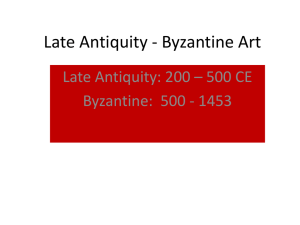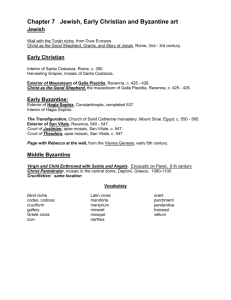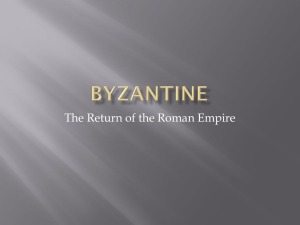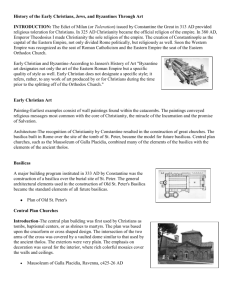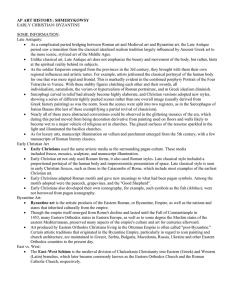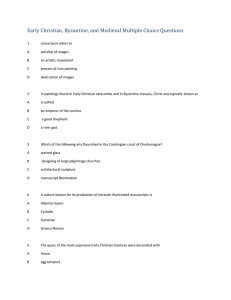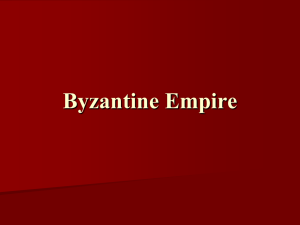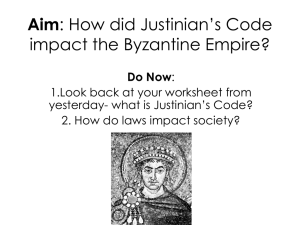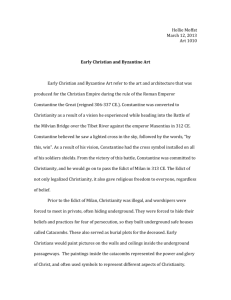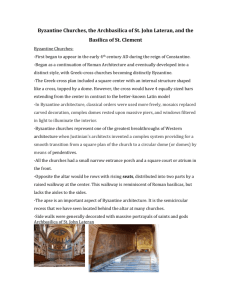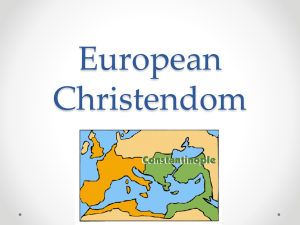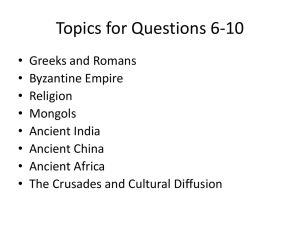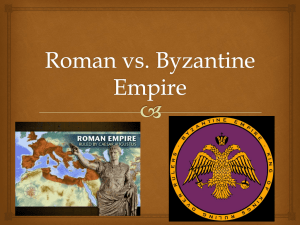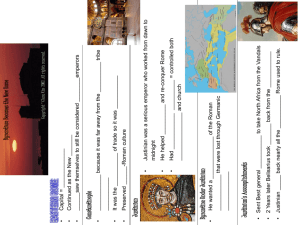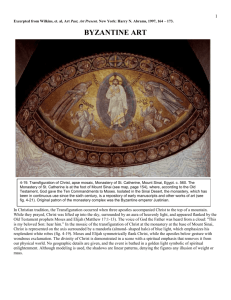File
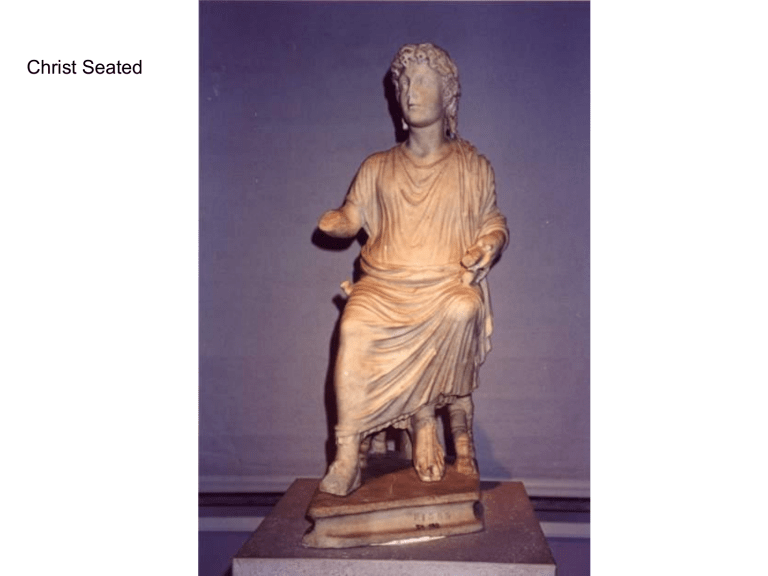
Christ Seated
• youthful, unbearded Christ, wearing a
Roman tunic and sandals sitting on a throne.
• Statue is unique b/c it is one of the rare examples of Early Christian statuary.
– Free-standing sculpture looked on w/ suspicion b/c of pagan cult statues
• ROMAN in style, CHRISTIAN in subject
Old. St. Peter ’ s Basilica (no longer standing),
322-27 CE
Plan
• Roman basilicas were the models for early
Christian churches
• Builders added a transept to look like cross
• Old St. Peter ’ s was commissioned by
Constantine-built on site where St. Peter was believed to be buried
• Model for basilicas all over world.
– Plain outside, beautiful inside
– Contrast was to remind Christians that the beauty of the
inner spirit was more important than the external beauty.
Reconstruction Drawing
(Interior)
Santa Sabina, Rome, Italy. c. 422
Interior of Santa Sabina, Rome,
Italy
• Modeled after Roman basilicas
• Features a timbered ceiling like Old St.
Peter ’ s
• Columns down the sides were usually taken from pagan temples.
• Corinthian columns lead eye to apse
Santa Costanza, Rome,
Italy. c. 350
Interior of
Santa
Costanza
• Plan and section
• Central-Plan design.
– Originally based off of old Myceneaen tholos tombs
– The building parts are of equal dimensions around the center –radiates out from the middle equally
• Originally a mausoleum, now a church.
– used as a tomb for Constantine ’ s daughter,
Constantina.
• Tall rotunda w/ a circular barrel-vaulted passageway called an ambulatory
– designed so that visitors could pass by without disturbing the mass.
• 12 sets of columns are placed along the ambulatory.
– The columns represent the 12 apostles.
– Columns have composite capitals
Mosaics in Churches
• The mosaics glistened on the inside walls and gave off a “ heavenly ” appearance
• Reflective tesserae was used instead of
Roman opaque glass. Could be angled to accent one area or figure.
• Tesserae-small pieces of limestone or marble
Parting of Lot and Abraham mosaic, church of
Maria Magiorre
• Tesserae mosaic about the Genesis story of
Abraham and nephew Lot parting ways
– Lot to Sodom and Abraham to Canaan
• Toga clad men share a look and turn away from each other
• Illusionistic style
– Overlapping heads
– Hint of perspective
– Sense of environment
Miracle of Loaves and Fishes,
Sant ’ Apollinare Nuovo, Ravenna, Italy
• Jesus is performing the miracle of the loaves and fishes-with minimal details
• Jesus is dressed in gold and purpleimperial colors
• He is identified by the NIMBUS- halo around holy figures- cross shaped halo that signifies his divinity.
• Directly facing the viewer, rigid formality
• Figures are becoming floating, flattened symbols instead of real people in real space
• Drapery shadows are narrow bars
• Gold --spiritual choice for backgroundenvironment not really important
• This mosaic shows the beginnings of
Byzantine style-transitional piece
Mausoleum of Galla Placidia,
Ravenna, Italy
• Galla Placidia was an empress who ruled the Western Roman Empire in mid 5 th c.
• Small cruciform church with domed covered crossing and barrel vaulted arms
• Exterior-plain and somber
• Interior-brilliantly colored mosaics
– Christ as the Good Shepherd here
Christ as the Good Shepherd, Galla
Placidia, Ravenna, Italy
Byzantine Background
• After the death of Constantine in 337, the
Roman Empire was split into Eastern and
Western Empires.
• The Western Empire went into a steady decline. Rome lost its power and was eventually sacked by Germanic tribes.
• The Eastern Empire, with its capitol in
Constantinople, gained great political strength.
• In 527, Justinian ascended the throne of the
Eastern Roman, or Byzantine Empire.
• He established Ravenna on the east coast as the new center of power.
• During his reign “ The Golden Age of
Byzantine ” , many beautiful churches and mosaics were built
• Byzantine artists worked for 1000 years creating glittering, heavenly works of art
Emperors and God
• No separation of church and state in the
Byzantine Empire
• Byzantine Emperors were considered to be Christ ’ s substitute on earth. They believed that the imperial will was God ’ s will.
• Justinian was a theocratic ruler- divine ruler
• Byzantine emperors were like pharoahs or ancient god-kings
Barberini
Ivory
• Justinian is on horseback with Christ above him--his power is divinely granted from
God.
• Christ is blessing Justinian indicating approval of his rule.
• Features that were adopted from the
Roman past:
On horseback (equestrian statues)
Dynamic twisting postures
Emperor as a triumphant general
St. Michael the
Archangel
(right leaf of a diptych)
Classical influences:
• Flowing clingy drapery
• Facial type and stylized hair
• Delicately incised wings
• Prototype of Michael was thought to have been a pagan winged victory (remember
Nike?)
New compositional devices:
• Feet hovering over the steps- like floating
• Upper body is in front of the columns and the lower body is behind them
• Real anatomy wasn ’ t important, the anatomy of the spirit was!
• The globe surmounted by the cross is a symbol for Christianity ’ s triumph
• Holding an imperial orb and scepter
• Might have been presenting it to
Justinian
Anthemius and Isidorus,
Church of Hagia Sophia
• Built in Constantinople
• Means Church of Holy Wisdom
• Patron: Justinian
• Architects: Anthemius and Isodorous
• Construction material: Brick, masonry
Plan and Layout
• A domed basilica with two half domes on either side
Plain exterior- elaborate interior
Turkish minarets were added when the Muslims conquered Constantinople and changed the church to a mosque.
Muslims painted over the mosaics inside, which were golden glass that was supposed to give off the feeling of heaven.
Now a museum of Byzantine art
Innovations
• Dome is supported by pendentives-concave triangular pieces of masonry used to support the weight of the dome at four corner piers.
• The dome is circular and rests on a rectangular base. This created more space inside.
Hagia Sofia (interior)
• Main light source: dome has halo of lights around it, 40 windows
• Created this mystical effect which made it look like the dome was resting on a halo of light
• ***LIGHT is considered to be the visual image of God!
Church of San Vitale, Ravenna,
Italy
• Patron: Justinian
• Built in honor of St. Vitalis, a Roman slave and martyred in the 2 nd century it is unlike any other church in Italy.
• Centrally planned (like Santa Constanza) the parts are almost equal dimensions around the center. 2 concentric octagons with a dome.
• The plan has an unusual feature in that the narthex is at an odd angle.
• It ’ s never been understood why it was placed at this angle.
![WALKER APAH Work 1: [left] Christ as the Good Shepherd, mosaic](http://s3.studylib.net/store/data/008199063_1-917d961612a5fa9b320b28077d9ae06b-300x300.png)
